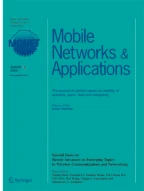Abstract
Existing image mosaicking algorithms generate a complete scene that incorporates a number of images captured by several cameras. The traditional image mosaicking approaches cannot be applied directly to the emerging Wireless Image Sensor Networks (WISNs), since the low performance of image transmission over wireless sensor networks causes a noticeable delay before an entire image is received by a control center node. In this work, we propose a Progressive Image Mosaicking Algorithm (PIMA) based on the multi-scan feature of Progressive JPEG (P-JPEG). The originality of PIMA is based essentially on how it successfully performs mosaicking by using incremental image quality, as opposed to traditional methods that require complete data from all images. PIMA builds mosaics of images that are decoded from P-JPEG scans at three levels of quality, and delivers an approximate view of the scene in a short time while the reception of further image data is still in progress. Thereafter, it updates the image registration on two other refined levels to gradually enhance the display quality. We also propose the concept of Richer Information and Likeliest (RIL) block pair, which is a variation of the Sum of Absolute Difference (SAD). RIL can improve significantly the accuracy of image registration. We have conducted an extensive set of experiments and evaluated our proposed schemes against selected existing approaches. Our performance results indicate that PIMA decreases the delay before the first display of the scene, while preserving equivalent performance and image quality when compared to existing patch-based image mosaicking algorithms.
Similar content being viewed by others
Explore related subjects
Discover the latest articles and news from researchers in related subjects, suggested using machine learning.References
Akyildiz IF, Melodia T, Chowdhury KR (2007) A survey on wireless multimedia sensor networks. IEEE Wirel Commun 14(6):32–39
Baker S, Matthews I (2004) Lucas-Kanade 20 years on: a unifying framework. Int J Comput Vis 56:221–255
Bartoli A, Coquerelle M, Sturm P (2004) A framework for pencil-of-points structures-from-motion. In: Proceedings of eighth European conference on computer vision (ECCV 2004), pp 28–40
Black MJ, Anandan P (1996) The robust estimation of multiple motions: parametric and piecewise-smooth flow fields. Comput Vis Image Underst 63(1):75–104
Boukerche A (2008) Algorithms and protocols for wireless sensor networks. IEEE, Wiley
Boukerche A, Feng J, Pazzi RW, Du Y, Huang Y (2008) Reconstructing the plenoptic function with wireless multimedia sensor networks. In: Proceedings of the 33rd IEEE conference on local computer networks (LCN 2008), pp 74–81
Matas J et al (2004) Robust wide baseline stereo from maximally stable extremal regions. J Image Vis Comput 22(10):761–767
Forstner W (1994) A framework for low level feature extraction. In: Proceedings of third European conference on computer vision (ECCV’94), pp 383–394
Fuh C-S, Maragos P (1991) Motion displacement estimation using an affine model for image matching. Opt Eng 30(7):881–887
Gennert MA (1988) Brightness-based stereo matching. In: Second international conference on computer vision, pp 139–143
MSU Graphics and Media Lab. Msu video quality measurement tool. http://compression.ru/video/quality_measure/video_measurement_tool_en.html. Accessed Jan 2009
Hampel FR, Ronchetti EM, Rousseeuw PJ, Stahel WA (2005) Robust statistics: the approach based on influence functions. Wiley, New York
Harris C, Stephens MJ (1988) A combined corner and edge detector. In: Proceedings Alvey vision conference, pp 147–152
He Z (2007) Video compression and data flow for video surveillance. Technical report CSD-91-646, Texas Instruments
Huber PJ (1981) Robust statistics. Wiley, New York
Kadir T, Zisserman A, Brady M (2004) An affine invariant salient region detector. In: Proceedings of eighth European conference on computer vision (ECCV 2004), pp 228–241
Lindeberg T (1990) Scale-space for discrete signals. IEEE Trans Pattern Anal Mach Intell 12(3):234–254
Lowe DG (2004) Distinctive image features from scale-invariant keypoints. Int J Comput Vis 60:91–110
Lucas BD, Kanade T (1981) An iterative image registration technique with an application in stereo vision. In: Proceedings of the 1981 DARPA image understanding workshop, pp 121–130
Mikolajczyk K, Schmid C (2004) Scale and affine invariant interest point detectors. Int J Comput Vis 60(1):63–86
Moravec H (1990) The Stanford cart and the CMU rover. In: Cox IJ, Wilfong GT (eds) Autonomous robot vehicles. Springer, New York, pp 407–419
Rousseeuw PJ, Leroy AM (2003) Robust regression and outlier detection. Wiley, New York
Shi J, Tomasi C (1994) Good features to track. In: Proceedings of ninth international conference on computer vision and pattern recognition (CVPR’94), pp 593–600
Stewart CV (1999) Robust parameter estimation in computer vision. SIAM Rev 41:513–537
Szeliski R (2006) Image alignment and stitching: a tutorial. Now, Hanover
Taubman DS, Marcellin MW (2002) JPEG2000—image compression fundamentals, standards and practice. Springer, Dordrecht
Triggs B (2004) Detecting keypoints with stable position, orientation, and scale under illumination changes. In: Proceedings of eighth European conference on computer vision (ECCV 2004), pp 100–113
Wallace GK (1992) The jpeg still picture compression standard. IEEE Trans Consum Electron 38(1):28–34
Zoghlami I, Faugeras O, Deriche R (1997) Using geometric corners to build a 2d mosaic from a set of images. In: Proceedings of IEEE computer society conference on computer vision and pattern recognition (CVPR’97), pp 420–425
Author information
Authors and Affiliations
Corresponding author
Additional information
This research is partially sponsored by grants from NSERC, the Canada Research Chair Program, the Ontario Distinguished Researcher Award, the Ontario Research Funds (ORF), and the Ontario Centres of Excellence (OCE).
Rights and permissions
About this article
Cite this article
Pazzi, R.W., Boukerche, A., Feng, J. et al. A Novel Image Mosaicking Technique for Enlarging the Field of View of Images Transmitted over Wireless Image Sensor Networks. Mobile Netw Appl 15, 589–606 (2010). https://doi.org/10.1007/s11036-009-0206-1
Published:
Issue Date:
DOI: https://doi.org/10.1007/s11036-009-0206-1
